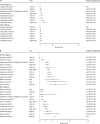Recent levels and trends in HIV incidence rates among adolescent girls and young women in ten high-prevalence African countries: a systematic review and meta-analysis
- PMID: 31607465
- PMCID: PMC7025003
- DOI: 10.1016/S2214-109X(19)30410-3
Recent levels and trends in HIV incidence rates among adolescent girls and young women in ten high-prevalence African countries: a systematic review and meta-analysis
Abstract
Background: The roll-out of antiretroviral therapy (ART) has changed contexts of HIV risk, but the influence on HIV incidence among young women is not clear. We aimed to summarise direct estimates of HIV incidence among adolescent girls and young women since ART and before large investments in targeted prevention for those in sub-Saharan Africa.
Methods: We did a systematic review and meta-analysis. We searched MEDLINE, Embase, Web of Science, Global Health, and CINAHL for studies reporting HIV incidence data from serological samples collected among females aged 15-24 years in ten countries (Kenya, Lesotho, Malawi, Mozambique, South Africa, Swaziland, Tanzania, Uganda, Zambia, and Zimbabwe) that were selected for DREAMS investment in 2015. We only included articles published in English. Our main outcome was to summarise recent levels and trends in HIV incidence estimates collected between 2005 and 2015, published or received from study authors, by age and sex, and pooled by region.
Findings: 51 studies were identified from nine of the ten DREAMS countries; no eligible studies from Lesotho were identified. Directly observed HIV incidence rates were lowest among females aged 13-19 years in Kumi, Uganda (0·38 cases per 100 person-years); and directly observed HIV incidence rates were highest in KwaZulu-Natal, South Africa (7·79 per 100 person-years among females aged 15-19 years, and 8·63 in those aged 20-24 years), among fishing communities in Uganda (12·40 per 100 person-years in females aged 15-19 years and 4·70 in those aged 20-24 years), and among female sex workers aged 18-24 years in South Africa (13·20 per 100 person-years) and Zimbabwe (10·80). In pooled rates from the general population studies, the greatest sex differentials were in the youngest age groups-ie, females aged 15-19 years compared with male peers in both southern African (pooled relative risk 5·94, 95% CI 3·39-10·44) and eastern African countries (3·22, 1·51-6·87), and not significantly different among those aged 25-29 years in either region. Incidence often peaked earlier (during teenage years) among high-risk groups compared with general populations. Since 2005, HIV incidence among adolescent girls and young women declined in Rakai (Uganda) and Manicaland (Zimbabwe), and also declined among female sex workers in Kenya, but not in the highest-risk communities in South Africa and Uganda.
Interpretation: Few sources of direct estimates of HIV incidence exist in high-burden countries and trend analyses with disaggregated data for age and sex are rare but indicate recent declines among adolescent girls and young women. In some of the highest-risk settings, however, little evidence exists to suggest ART availability and other efforts slowed transmission by 2016. Despite wide geographical diversity in absolute levels of incidence in adolescent girls and young women, risk relative to males persisted in all settings, with the greatest sex differentials in the youngest age groups. To end new infections among the growing population of adolescents in sub-Saharan Africa, prevention programmes must address gender inequalities driving excessive risk among adolescent girls.
Funding: This work was conducted as part of a planning grant funded by the Bill & Melinda Gates Foundation.
Copyright © 2019 The Author(s). Published by Elsevier Ltd. This is an Open Access article under the CC BY 4.0 license. Published by Elsevier Ltd.. All rights reserved.
Figures






Comment in
-
HIV incidence rates in adolescent girls and young women in sub-Saharan Africa.Lancet Glob Health. 2019 Nov;7(11):e1470-e1471. doi: 10.1016/S2214-109X(19)30404-8. Lancet Glob Health. 2019. PMID: 31607449 No abstract available.
References
-
- UNAIDS . UNAIDS; Geneva: 2016. Global AIDS update 2016.https://www.unaids.org/en/resources/documents/2016/Global-AIDS-update-2016
-
- UNAIDS . UNAIDS; Geneva: 2014. 2014. The Gap Report.http://files.unaids.org/en/media/unaids/contentassets/documents/unaidspu...
Publication types
MeSH terms
LinkOut - more resources
Full Text Sources
Medical

